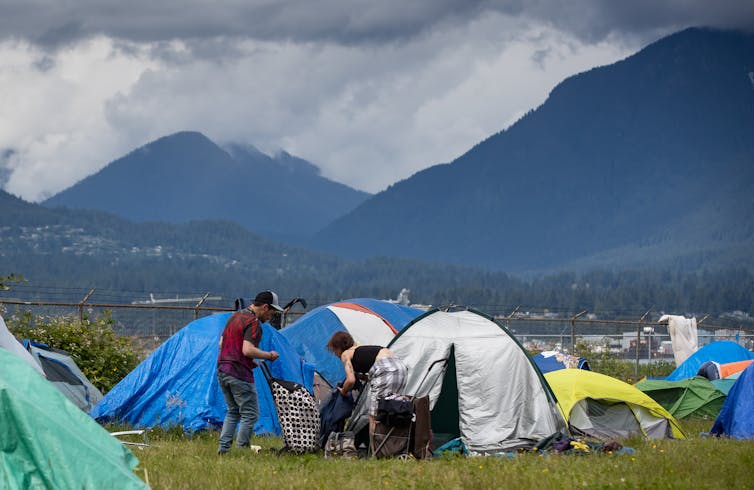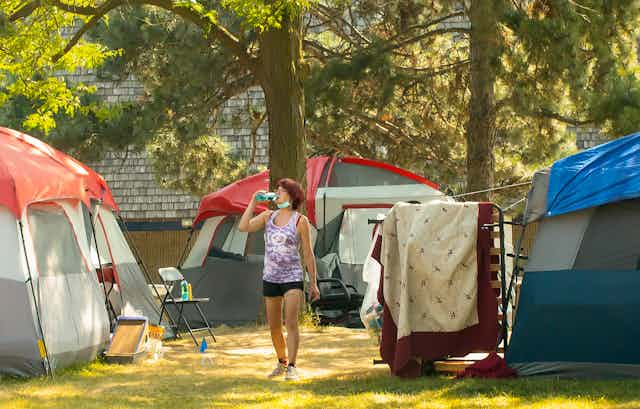The COVID-19 pandemic has prompted calls to suspend evictions of homeless encampments. Victoria, Edmonton, Toronto and other cities did so.
But many were soon back at it. Forcible decampment of homeless people continued, albeit with greater emphasis on securing housing, but with knowledge that some residents would be left unhoused.
Suspending homeless camp evictions during the pandemic is a start, but it is not enough. The problem is failed housing policies, not COVID-19. A central pillar of those policies is continual, forcible displacement of homeless people from places where they engage in essential life-sustaining activities.
Canadian courts have condoned this cycle of continual displacement. Homeless individuals have a right to camp temporarily in certain public places when housing is unavailable, but governments may restrict them to a few limited areas, force them out every morning and prohibit camping everywhere else.
Nowhere to shelter legally
The upshot? Almost nowhere in Canada can homeless people legally erect even the most rudimentary shelter.
When they do, governments’ standard response is to order them to leave and, usually sooner than later, get injunctions forcing them out. Homeless campers rarely win such cases and often lose when authorities document health and safety hazards and interference with housed neighbours’ esthetics and recreation.

What’s wrong with this strategy of forcible decampment?
For a start, it exacerbates the risks of COVID-19. Homeless people are highly vulnerable to COVID-19. Homeless camps are often crowded and unsanitary. Things worsened as COVID-19 caused encampments to grow.
But eviction is not a solution. The U.S. Centers for Disease Control and Prevention, and later its B.C. counterpart, warned that clearing encampments can disperse homeless people throughout the community and sever connections with service providers, increasing the potential for COVID-19 spread.
By contrast, leaving camps in place eases testing, monitoring, contact tracing and service delivery. So both agencies urged governments to allow homeless encampments to stay during the pandemic if individual housing was not immediately available, and to co-operate with relevant agencies to establish hygiene and physical distancing in camps.

Six more reasons to stop homeless evictions
But here are six reasons why forcible decampment is bad policy even without COVID-19:
-
It ignores the benefits of encampments. The risks are familiar: overdose, crime, fires, discarded needles, garbage, etc.
But homeless camps also provide benefits like stability, safety, autonomy, community, overdose prevention, access to services and storage for belongings. With supports like water, toilets, naloxone kits, waste collection and fire equipment, camps can deliver these benefits while moderating the problems.
It ignores the harms of continual displacement. Homeless people who are constantly displaced lose connections with family, friends and services. Their mental and physical health suffers. Their overdose risk increases. They have less control over their lives and possessions. They are pushed into “a relentless series of daily moves” among streets, parks and underpasses where they are often alone and unsafe.
-
It inevitably leaves some people unsheltered. Shelter spaces are often practically inaccessible due to restrictions on partners, pets, guests, belongings or substance use. Mental health challenges and experiences of violence or abuse are barriers for some people.
Fear of COVID-19 — understandable given outbreaks in shelters — compounds these obstacles. In short, even when governments make efforts to offer housing, some homeless people simply cannot accept it and authorities know that significant numbers will be left with nowhere to go.
-
It traumatizes homeless campers. Seventy per cent of homeless people report past trauma or abuse.
In an eviction, tents and belongings are destroyed. People may have to leave with what they can carry. Police sometimes fence campers into progressively shrinking areas, reproducing legacies of dispossession and incarceration, especially for Indigenous people.
It perpetuates a revolving door of eviction. The lack of legal protections enjoyed by renters combine with “one warning” rules and mental health challenges to mean that many people placed in housing are soon evicted again. At least one person was evicted from COVID-19 emergency housing only to die on the streets of Toronto.
It can create an arbitrary housing lottery. When some encampments are selected for high-profile housing blitzes while others are evicted without any plan for where residents go next, homeless people compete to establish tent cities as a path to housing. Lucky residents of the chosen camps receive arbitrary priority over others who have been unable even to get on waiting lists.
Vancouver’s missed opportunity
These problems were illustrated by the province’s clearance of Vancouver’s Oppenheimer Park during COVID-19. Around 90 per cent of the park’s residents accepted housing, but significant numbers were left unsheltered.

Authorities knew this would happen. With no-camping bylaws in city parks, the campers had few options. Just as public health agencies warned, they dispersed throughout the community.
Some moved to an unused, unfenced parking lot owned by the Vancouver Fraser Port Authority, a federal government agency.
This was a move from the frying pan into the fire.
This camp had modest problems compared to Oppenheimer Park. It was on unenclosed public land the government had no immediate use for, away from homes and businesses yet easily accessible by service providers. If any camp deserved to stay in place during COVID-19, it was this one.
‘Pesky trespassers’
Instead of heeding public health advice and co-operating to make the camp reasonably safe during the pandemic, the Port Authority immediately applied for an eviction injunction.
The court agreed, setting a precedent that lowers the bar for evicting homeless encampments from public land. The court held that this unfenced, unused government land was private property and the Port Authority could evict homeless people as pesky trespassers.
The Port Authority made no pretense of trying to secure housing for the residents, who dispersed throughout the community again. Some moved to nearby Strathcona Park, where a new tent city grew quickly.
Unfortunately, on July 14, Vancouver missed an opportunity to reconsider the policy of forcible decampment. The Park Board approved new bylaws that allow overnight shelter in parks but require homeless campers to clear out at 7 a.m. every morning. These new bylaws perpetuate the policy of continual displacement.
Instead, what governments — Vancouver included — should do is authorize and support stable day and nighttime encampments while the housing crisis persists. The COVID-19 pandemic may still prove to be a catalyst for this reconsideration.

